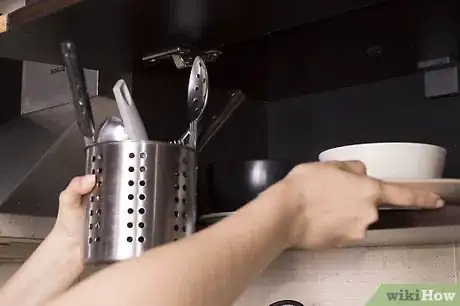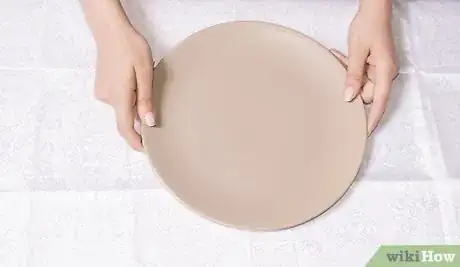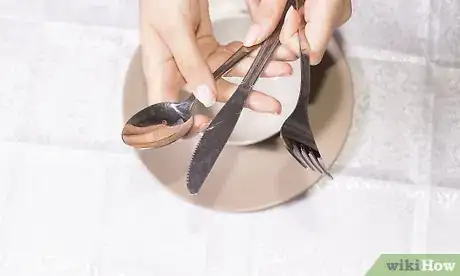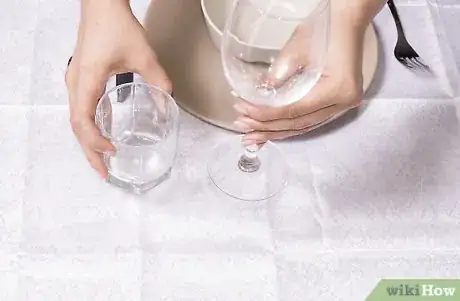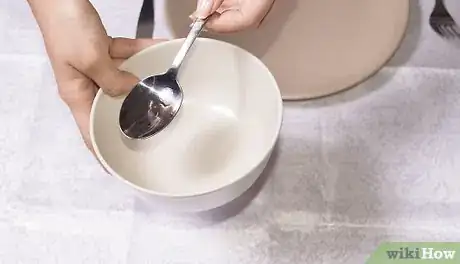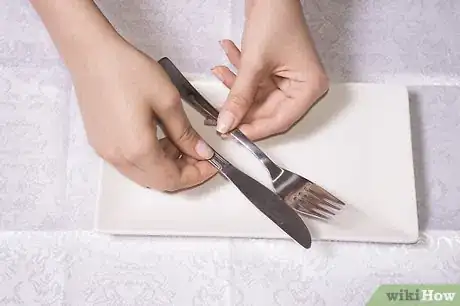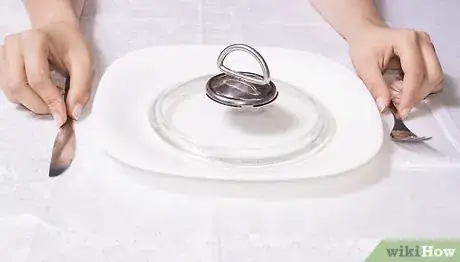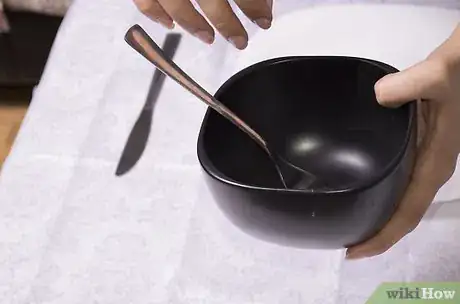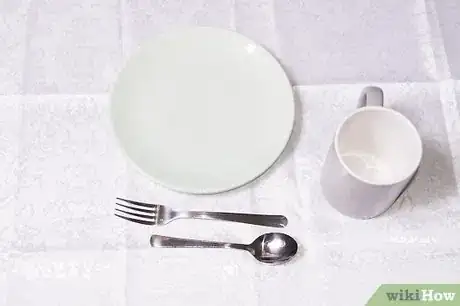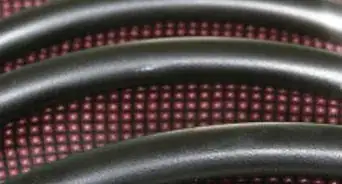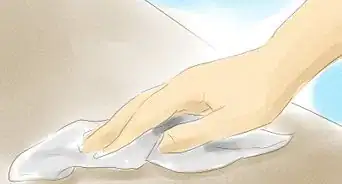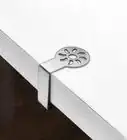X
wikiHow is a “wiki,” similar to Wikipedia, which means that many of our articles are co-written by multiple authors. To create this article, 38 people, some anonymous, worked to edit and improve it over time.
This article has been viewed 384,075 times.
Learn more...
In today's hectic world of fast-food restaurants and TV dinners, it's easy to forget how to properly set the table for a formal dinner. While it may not be a skill you need often, occasions do still arise for which formal place settings are an absolute must. Learn the basics and you'll be ready to host (or attend!) any formal dinner with ease.
Steps
Formal Place Setting Template
Part 1
Part 1 of 2:
Arranging the Original Setting
-
1Decide what courses you’re going to serve. The ultimate setting you provide your guests with will depend on which courses you decide to serve; a five or seven course meal is typical for a formal dinner. Decide on your menu, keeping in mind that the typical courses are served in the following order:[1]
- First course: Appetizer/shellfish
- Second course: Soup
- Third course: Fish
- Fourth course: Roast
- Fifth course: Game (for a 5 course meal, the fourth/fifth courses are combined as the entrée of choice).
- Sixth course: Salad (yes, salad really does come after the entrée)
- Seventh course: Dessert
- Eighth course: Fruit, cheese, and coffee (optional)
- Ninth Course: Nuts and raisins (optional).
-
2Select your utensils and dishes. Prior to setting your table, you’ll need to make sure you have the proper utensils and dishes prepared. You’ll need one fork for each of the meat dishes (a seafood fork should be used for a seafood appetizer), a spoon for the soup and dessert, knives for the entrée, butter, and fish (if served), a charger, a dish for the butter/bread, and a selection of glasses (a water goblet, glass for white wine, glass for red wine, and a champagne flute are all options).
- Each course is brought out of the kitchen on its own dish, so don’t worry about providing the dishes in the setting.
- Prepare cloth napkins with napkin rings as an additional decorative element on the table.
Advertisement -
3Set the dishes. The centerpiece of the place setting is the charger. This is a large dish that goes beneath each of the plates the courses are brought out on. The charger will remain on the table until after the entrée has been consumed, and then it should be removed along with the entrée plate. Place the charger in the center of each setting. The second dish that you should have is the butter/bread dish. This will be placed up and to the left of the charger.
- When you remove plates before the entrée, leave the charger and take just the empty plates.
- You should have an assortment of bread for your guests to eat, which is the purpose of the bread/butter dish.
- Your cloth napkin should be placed on top of the charger.
-
4Set your utensils. Although having three forks, two knives, and two spoons may seem like a frightening prospect, their placement is actually quite simple. With you utensils, you use them from the outside in. So, on the left side of the charger, you should have your fish fork > salad fork > entrée fork. On the right side of your charger, you will place your dinner knife > fish knife > soup spoon. Above your plate aligned horizontally, you should place your dessert spoon and optional dessert fork. The butter knife should be placed diagonally across the butter/bread dish.
- Each utensil will be removed from the table once it has been used.
- If you’re not serving fish, then there is no need to place a fish fork and fish knife on the table.
- If you serve shellfish as an appetizer, a shellfish fork should be placed to the right side of the soup spoon. This is the only fork that may be placed on the right side of the table.
- Each of the utensils should be evenly spaced from each other and the charger.
-
5Set your glasses. The glasses you choose to use will vary on what you are serving with dinner. Traditionally, there is at least a water goblet and a glass for wine, but this may vary. Place the water goblet directly above the knife, level with the bread/butter dish. Add your wine glass to the right of that, typically above the soup spoon. If you add a third wine glass (for a different kind of wine), place it above and between the water glass and the first wine glass. An optional champagne flute can be included as well, and should be placed above and to the right of the first wine glass.
- Similar to the utensils, your glasses should be placed in order of use.
- Water is often served already in the glass, while wine and champagne are poured during the courses.
- If you choose to serve coffee (as in a nine course meal), the coffee should be brought out in a demi-tasse (a type of espresso cup) at the end, and removed with the fruit/cheese plates.
Advertisement
Part 2
Part 2 of 2:
Adjusting the Table Setting for Each Course
-
1Set the table for soup. For the first course of soup, there are two options: bring bowls of the same soup from the kitchen, or offer water or cream based soups and serve them in fresh dishes at the table. The former is served already poured in bowls and brought out from the kitchen. The latter is served (carefully) at the table into clean bowls. The soup bowls should be brought in on serving dishes in case of a spill. When everyone has finished eating their soup, the soup spoons should be placed (bowl-side up) on the right side of their bowl, on the serving plate.
- The plate, bowl, and spoon should be removed from the table after the first course.
- The bread and butter dish should remain on the table, even if they were used with the soup.
-
2Set the table for fish. With the soup removed, the fish course should be brought in on its own dish. This should be placed on the charger, and eaten with the fish knife and fish fork (the utensils furthest from the charger on either side). When the fish has been consumed, the fish fork and fish knife should be placed diagonally across the dish, with the handles of each placed on the ‘4:00’ mark as if the plate were a clock.
-
3Set the table for the main course. The main course should be brought out on a large plate that has been pre-warmed. This should go on the charger, and is eaten with the dinner fork and knife. When everyone is finished with the entrée, the plate can be removed along with the charger, the dinner fork, and the knife. The knife and fork are typically placed diagonally across the plate, in a similar fashion to the utensils used for the fish.
-
4Set the table for the salad. The salad is typically eaten after the entrée in a formal dinner. With the charger removed, place the salad plate in the center of the setting. This should be eaten with the last remaining fork. When the salad course is finished, the salad plate, salad fork, and bread/butter dish with the butter knife, and the wine/champagne glasses should all be removed. All that should be left is the water goblet and the dessert spoon (and optional dessert fork).
-
5Set the table for dessert. The final course of the evening is typically dessert and coffee, unless you’re serving a very formal nine course dinner. Regardless, the desert should be brought in on a plate and placed in the center of the setting, and a demi-tasse or teacup should be placed to the right of it below the water goblet with a teaspoon. Cream and sugar may be placed on the table for use in the coffee or tea, if desired. When dessert is completed, all the dishes should be removed, leaving a bare table.[2]
Advertisement
Community Q&A
-
QuestionIf they have a choice of soup or salad, what utensils do I set?
 Community AnswerLeave the salad fork and soup spoon already placed in the original setting on the table. Once the soup or salad is served the guest will pick the appropriate utensil. However, if you are having a less formal dinner party, you can bring the salad fork or soup spoon when you serve either one.
Community AnswerLeave the salad fork and soup spoon already placed in the original setting on the table. Once the soup or salad is served the guest will pick the appropriate utensil. However, if you are having a less formal dinner party, you can bring the salad fork or soup spoon when you serve either one. -
QuestionWhen is the bread placed on bread dish for a formal multi-course dinner?
 Community AnswerIt should already be on the bread dish when that dish is brought to the table, typically before the guests are seated.
Community AnswerIt should already be on the bread dish when that dish is brought to the table, typically before the guests are seated. -
QuestionHow much space does each setting typically use?
 Community AnswerDepending on the number of courses you are serving, how many beverages you want to serve, and how strictly formal you want to be, the size of the actual setting will vary. See the template and experiment with your own dishes to see how much space you will need, but don't set up for a five course meal when you plan to serve a seven or nine course meal, and vice versa.
Community AnswerDepending on the number of courses you are serving, how many beverages you want to serve, and how strictly formal you want to be, the size of the actual setting will vary. See the template and experiment with your own dishes to see how much space you will need, but don't set up for a five course meal when you plan to serve a seven or nine course meal, and vice versa.
Advertisement
References
About This Article
Advertisement


